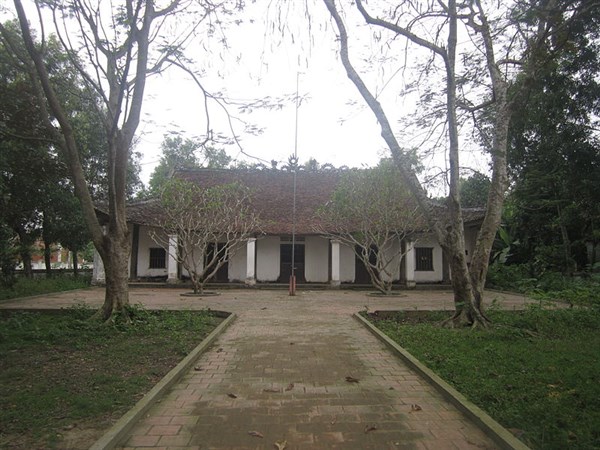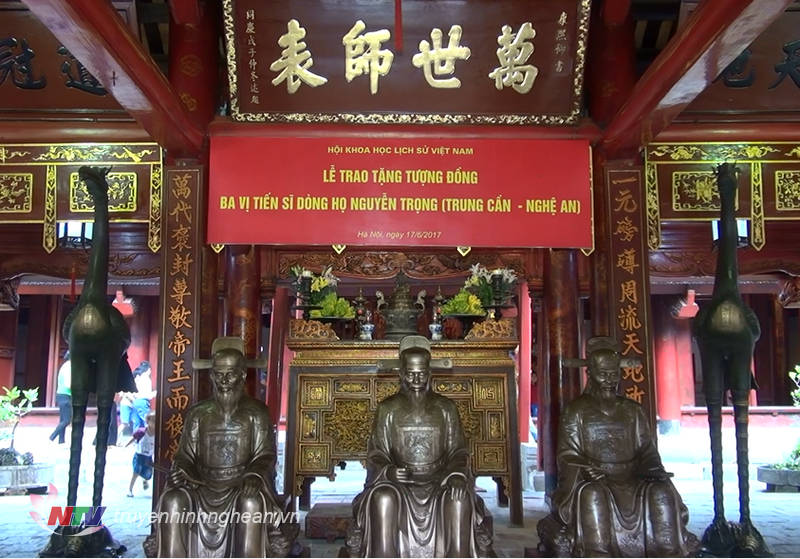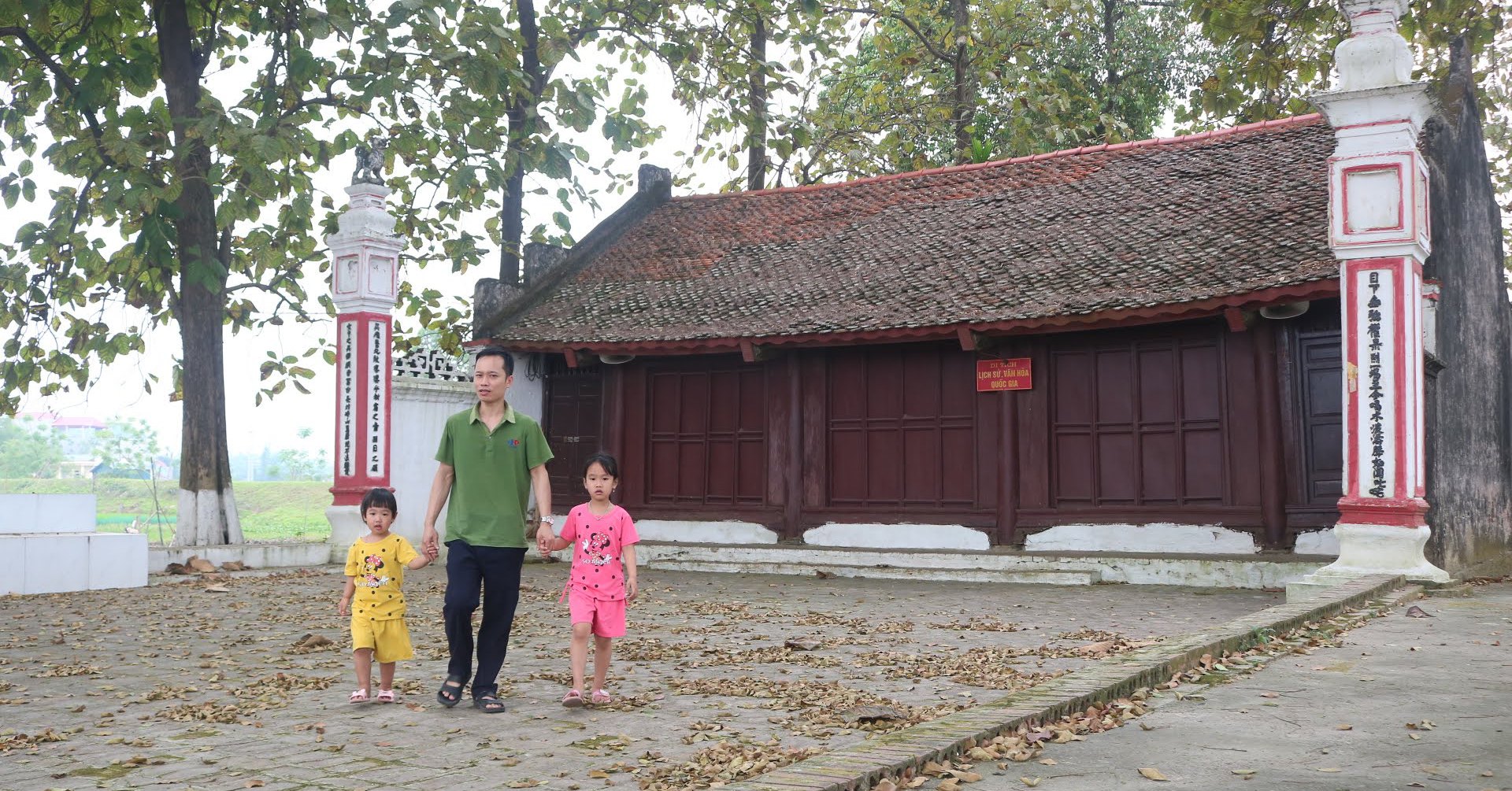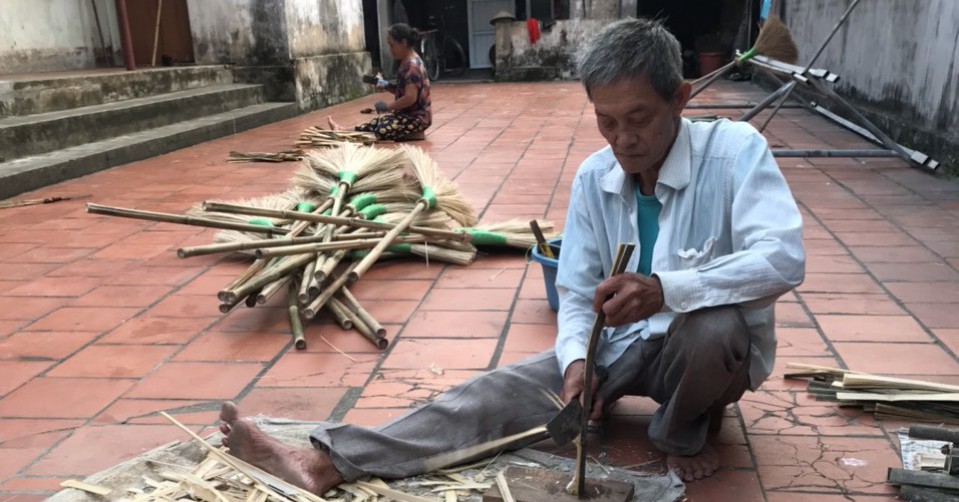Quan Trung Can, Duong Lieu

Trung Can communal house (former Nam Trung commune) now belongs to Trung Phuc Cuong commune, Nam Dan district.
Lying on the right bank of the blue and gentle Lam River, about two kilometers away, there is a majestic and majestic Thien Nhan mountain range connecting with Huong Son (Ha Tinh) is Trung Can, my village. The name Trung Can is taken from the sentence “Sister is precious Trung Can, noble woman is favorable” (a precious son is industrious honesty, a precious daughter is in chastity and agreement). The book “Dai Nam Nhat Thong Chi” records that the land of Trung Can later, in the late 15th century and early 16th century, was named Trang Can Cung, belonging to Nam Hoa Thuong, Tong Nam Hoa, Thanh Chuong district. At the end of the 19th century, Canton of Nam Hoa changed to Canton of Nam Kim and Trung Can commune was still of Canton of Nam Kim but was merged into Nam Dan district in 1910. Historically, in 1505, the land of Trang Can Cung (later Trung Trung). Can) has Tong Tat Thang obtained his doctorate and became the Duke of Nghia, and was honored by the people in the area as the village’s tutelary god. Following the predecessors, Duke Nguyen Nhan My (under Le Trung Hung) and Governor General Le Nguyen Trung (under the Nguyen Dynasty) as well as other talented people later expanded and developed the countryside of Trung Can and Nam Trung today. the more prosperous.
Historical and cultural researchers, and “Arts” experts all say that if Quynh Luu is famous for having Quynh Doi village with many academic achievements, then Nam Dan has Trung Can village, which is a land of “talented human genius” with Dr. Tong Tat Thang is the “flowering” character of the village. In the book “Angel Science (1075 – 1919)”, author Dao Tam Tinh has a statistic about the number of passers-by in Quynh Doi village (accounting for 17% of the province) and Trung Can in Nam Dan district (accounting for more than 17% of the province’s total). 11%). When I was still alive, my father (an employee at the Second Vinh Court, during the anti-French resistance war) told me that in Khoa Truong hamlet next to my Gat hamlet, there were three fathers and sons, their cousin Nguyen Trong all passed. doctorate and was sent as a missionary 5 times. Their merits are engraved on the stone stele Van Mieu – Quoc Tu Giam and recorded in the calendar of the reign of the dynasty, Nghe An signing… That is Nguyen Trong Thuong (1681 – 1737), at 32 years old he passed the Third Third Circuit with a bronze doctorate in science. Nham Thin, year of Vinh Thinh 8 (1712) of Le Du Tong’s reign.
Nguyen Trong Thuong worked as a minister of civil servant, he was sent by the imperial court to be an envoy of the Qing Dynasty. When it expired, on the way home, unfortunately, he suddenly fell ill and died. Nguyen Trong Thuong’s son, Nguyen Trong Duong (1724 – 1786), 46 years old, passed the Third Third Circuit, a co-doctorate in the Ky Suu Department, and was named Canh Hung in the 30s of Le Hien Tong’s reign. He worked as an official of the Academy of Sciences and was sent to the Qing Dynasty (1761); When he returned, he was appointed Governor of Lang Son town, and stripped of La Son Ba. During his time as a mandarin in the Land of Lang, he was the one who built the Ngong Duc monument and wrote the epitaph marking the Vietnam-China border.
Nguyen Trong Duong (born in 1746, year of death is unknown) is the son of Nguyen Trong Duong, who passed the Third Circuit, a co-doctorate in the Ky Hoi Faculty, with the era name Canh Hung 40 (1779) of the Le Hien Tong dynasty. He worked as an official of the Academy of Medicinal plants, obeying the imperial order as a deputy ambassador to the Qing Dynasty. When he returned home, he was promoted to Thi Che, promoted to the governor of Lang Son town, and at the beginning of the reign of King Gia Long, he died. During the reign of King Minh Mang of the Nguyen Dynasty, the son of Doctor Nguyen Trong Duong, Nguyen Trong Vo, was honored to be sent by the court twice to China. So later, in the church of the Nguyen Trong family in Trung Can, a couple of parallel sentences hung: The national body of the five flowers coincides with the culmination of the year/Thu Huong Tam The Five Hoang Hoa (rough translation: Five times to go to China to honor the nation / Three generations to spend bright yellow flowers and incense).
It was the father and son of Dr. Nguyen Trong Duong and some brothers in the family (mainly contributing), and mobilized people in the area to contribute to the construction of Trung Can communal house (1781-1782) – one of the most famous communal houses in the world. has the most beautiful architecture in the central region. The work is the place to worship the village lord Tong Tat Thang and the Four Great Kings, Cao Son Cao Cac, which has been classified as a National Historic Site by the Ministry of Culture and Information (now the Ministry of Culture, Sports and Tourism) 1996.
One of the big families with a tradition of studying and passing in Trung Can village is the Nguyen Huu family. According to the genealogy of this family, the ancestor of the family is Nguyen Huu Nhuan Oc (originally from Vinh Tuong district – Vinh Phuc province) who moved to live and settled in Trang Can Cung (later Trung Can) around circa. the first half of the 16th century. The Nguyen Huu family developed in all aspects, especially the academic path from the 9th generation onwards.
Notable among them is Nguyen Huu Duc (also has documents as Nguyen Trong Duc, name To Lam), born in 1799, died in 1858 (whose second wife is Nguyen Thi Dam, youngest daughter of the great poet Nguyen Du). . He passed his bachelor’s degree at the age of 26, was appointed Tri by the court in Yen The district, then Trieu Phong by the court. Nguyen Trong Duc’s nature is upright, generous, loves loyal people, hates sloppy people. Under Minh Mang, he was conferred from the Academy of Poetry and Poetry and then the Academy of Poetry, concurrently holding the position of Supervisor of History.
His younger brother Nguyen Van Giao, branded Quat Lam (1811 – 1863), passed the bachelor’s exam at the Giap Ngo faculty (1834), the 15th Minh Mang reign. Because he was falsely suspected of being involved in the exam at Nghe An exam school, so he and a few others were sentenced to “life in vain”. About 18 years ago, when he returned to his hometown to teach, he wrote many works on both Chinese history and Vietnamese history, such as “History” and “Southern history theory”. Especially about poetry, Detective Hoa Nguyen Van Giao left the book “Dam like then Thao”, in which there is a song about the cuckoo “.Or hunchback, or crouch, or fly/ Missing a step like this/ May God let go of the cage to give it a try/ Here you are flying nine clouds“. King Tu Duc was originally a lover of poetry, so when he heard this poem by Nguyen Van Giao, he guessed that there was a sense of confusion, so the king issued an order to remove the author’s sentence.

Bronze statue of 3 doctors in Trung Can village.
In 1852 he passed the Nguyen exam and the following year in 1853, Nguyen Van Giao passed the Hoi Nguyen exam, then he passed the Dinh Ong exam and passed the First Doctorate, the third name (ie Tham Hoa). His fellow student who passed the Tham Hoa exam was Nguyen Duc Dat from Hoanh Son village (later Nam Hoanh commune) about two kilometers from Trung Can. Do university, but Nguyen Van Giao is only an official of Thua Thua Academy, a cabinet counselor specializing in drafting and checking all kinds of documents in the court, so Tham Hoa Giao still lives in a poor family. The wife and children still have to weave cloth, spin silk, and increase corn and beans all year round.
Talking about the Nguyen Huu family in Trung Can village, Nam Trung commune (now Trung Phuc Cuong), it is impossible not to mention Nguyen Huu Lap (son of Nguyen Trong Duc, calling Detective Hoa Nguyen Van Giao by uncle). Nguyen Huu Lap from Noa Phu, alias Thieu To, was born in 1824 and died in 1874, it is said that he was famous for his intelligence and good learning from a young age.
At the age of 14, he passed the Baccalaureate exam for the first time, the Nham Tuat faculty of the 15th Tu Duc period (1862), Nguyen Huu Lap took the Hoi exam and won the third name, and then Dinh won the second title of the doctorate of origin, the first name (ie Dinh Nguyen. Hoang Giap). His life as a mandarin has undergone many positions such as: Tri Phu Vinh Tuong, Son Tay Court, Chief Judge of Thua Thien Exam School, Binh Bo Friendship, Consortium of Ministers, Academy of Thieves.
Notably, in the years 1871 – 1872, Hoang Giap Nguyen Huu Lap was appointed by King Tu Duc as chief ambassador to the Qing Dynasty. A special feature on Nguyen Huu Lap’s path is the spirit of “war leader” before the invasion of the French colonialists. That thought is expressed very clearly in the poem Dinh Dinh by Hoang Giap Lap that, in the context of the country’s turmoil, the court must know how to rely on the people’s strength, do everything in accordance with the people; If you want to keep the country, you must strengthen and build a powerful military force.
He pointed out, “Our country and the Western invaders have no inherent rivalry, but these past three or four years they have invaded our country’s waters … according to logic, we are right and they are wrong”. Therefore, Nguyen Huu Lap proposed to the king, on the one hand, to find talented people to have a wise relationship with the French, on the other hand, practice militiamen day and night, hoard food, and guard closely in all regions. In order to make peace in the end, it was not possible to rely on soldiers, the enemy had to fight… unfortunately, the recommendations of Hoang Giap Nguyen Huu Lap were not accepted by the king.
In the end, before the weakness of King Tu Duc, the six provinces of Cochinchina in turn fell into the hands of the enemy and then the Vietnamese people were immersed in the long night of slavery by the French colonialists for 80 years… According to researchers Han Nom, Nguyen Huu Lap is a cultural connoisseur and he himself transcribed the work Truyen Kieu (in 1870) – one of the oldest documents currently kept at the Institute of Han Nom Studies.

Church of branch 2, family Nguyen Huu Trung Can village – a place to worship father and son Nguyen Huu Duc and Nguyen Huu Lap.
The scholarly and talented tradition of the ancient ancestors of the Trung Can region has also forged and produced many characters who have contributed in all fields of modern social life. It was Comrade Nguyen Tiem (1912 – 1932), member of the Standing Committee of the Central Party Committee, the first Secretary of the Provincial Party Committee of Nghe An province, Nguyen Trong Canh (also known as Tran Quoc Hoan), former member of the Politburo – Minister. Vietnam’s first police; Mr. Nguyen Nhuong, Nguyen Huu Dan – revolutionary soldiers in Nghe Tinh Soviet period; Nguyen Tu Nghiem – famous painter in the quartet “Lien – Nghiem – Sang – Phai”.
And in the context of the renewal of the country today, the old saying “Quan Trung Can, people of Duong willow” is no longer relevant. Because Trung Can village as well as Duong Lieu village (former Nam Trung commune), as far as I know, there are currently dozens of professors, associate professors and doctorates operating in the fields of economics, education and training, science and technology. technology, culture, art and people’s health care…
Electronic media Vietnamese people Open the “Village Storytelling” column from March 4, 2020. The column is for all professional and amateur writers who have a love for the countryside and want to share their true stories with readers.
The article must not have been published in any mass media or publication. Authors please specify full name, pseudonym (if any), contact address, email, phone number, account number receiving royalties.
The best and most quality articles will be selected to award prizes every 2 months.
Articles in collaboration with the “Village Storytelling” column should be sent to email: [email protected]; Contact phone: 0903226305.
We look forward to the cooperation and cooperation of readers and authors!
at Blogtuan.info – Source: danviet.vn – Read the original article here



